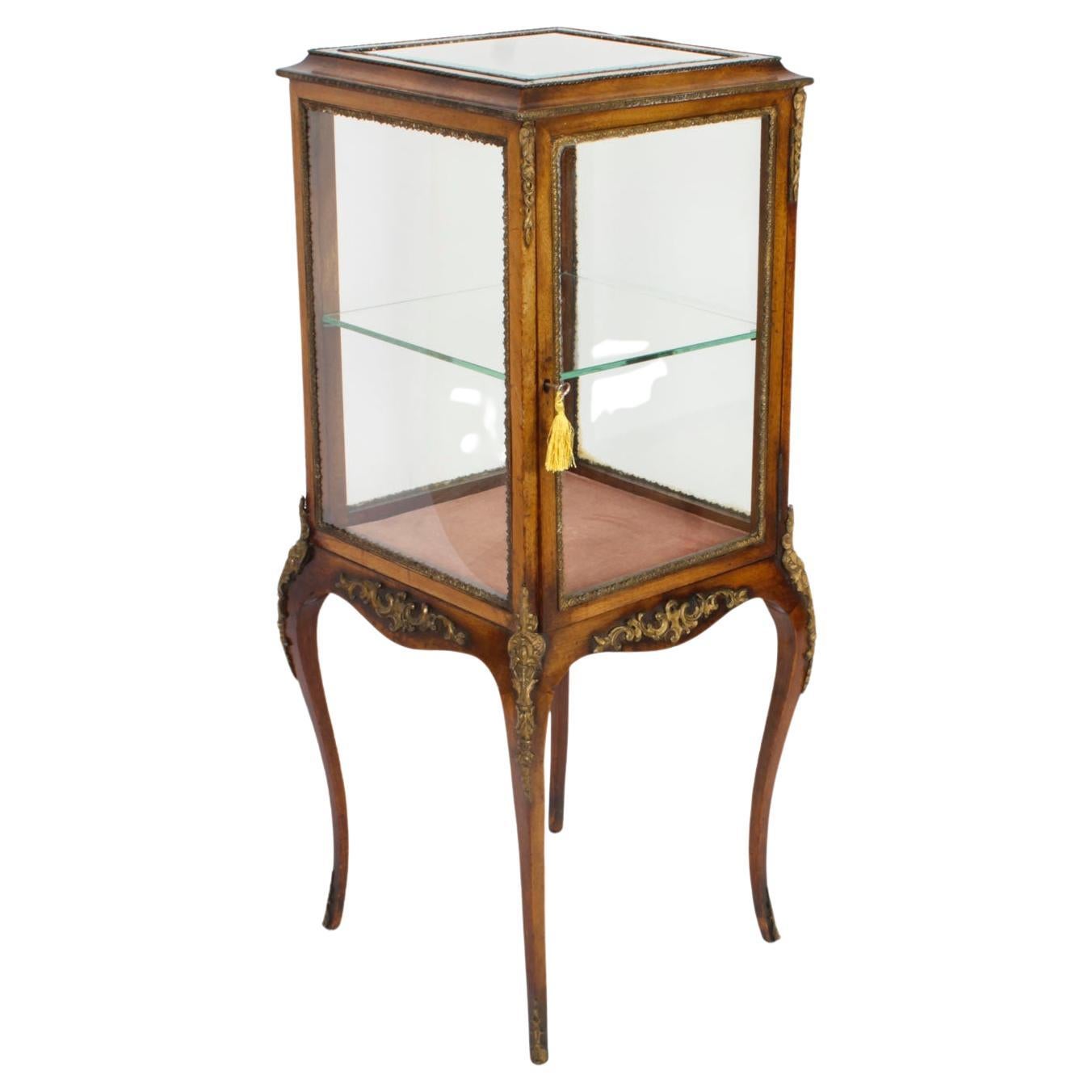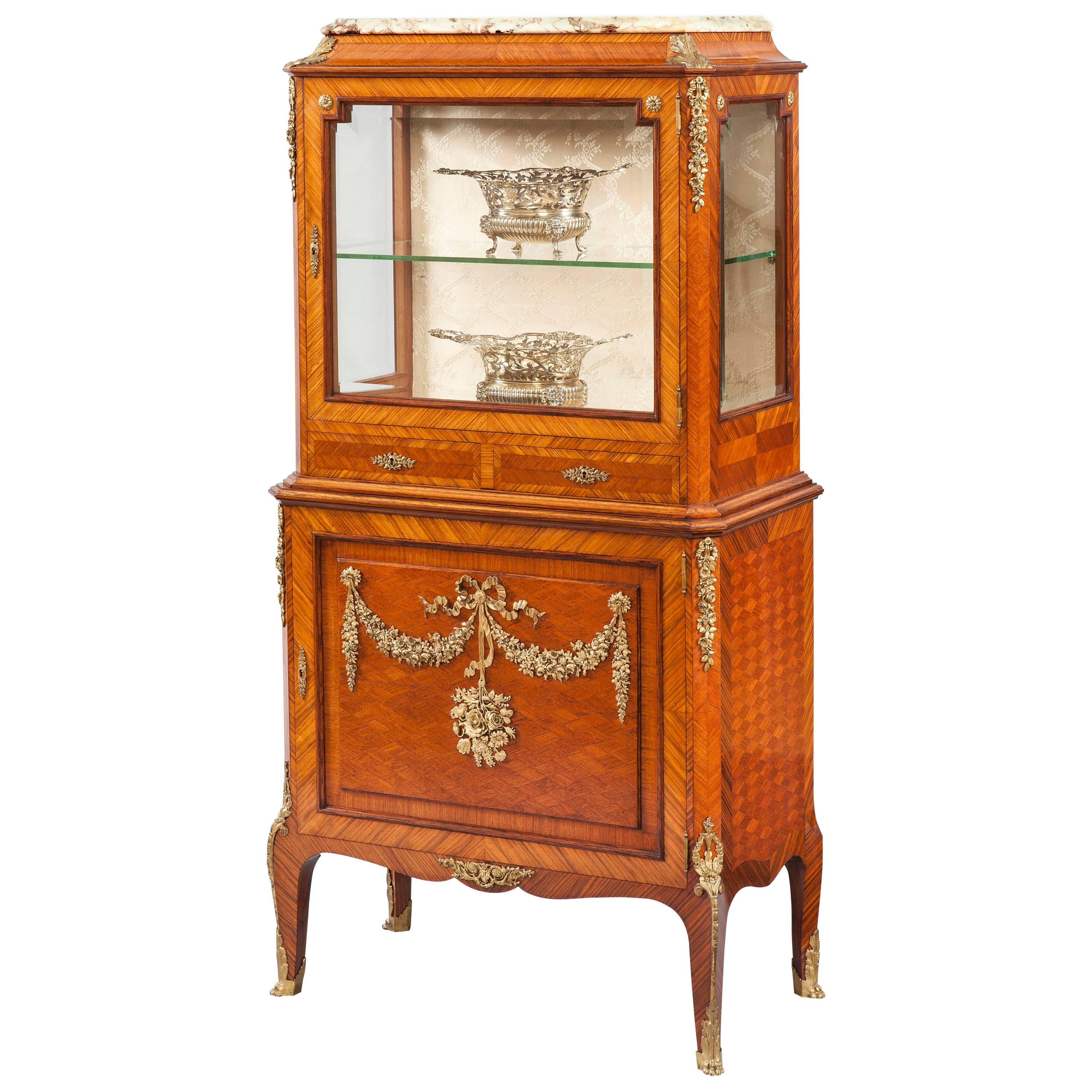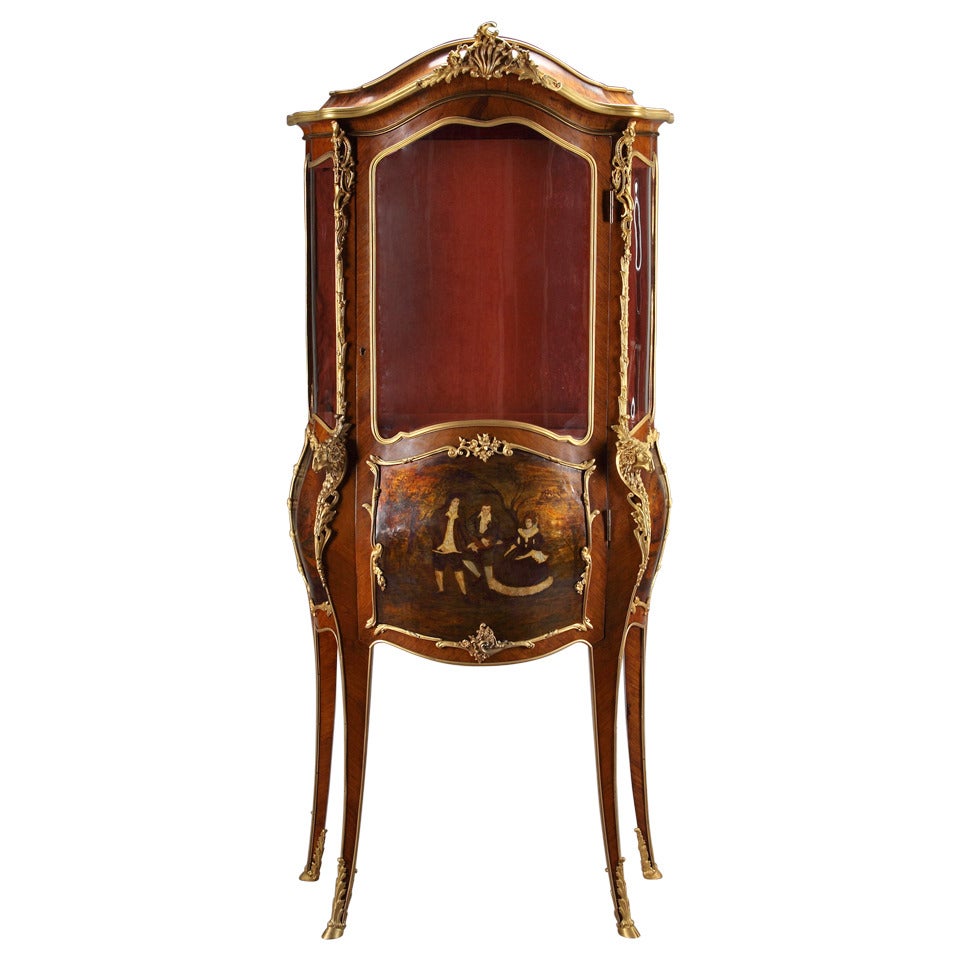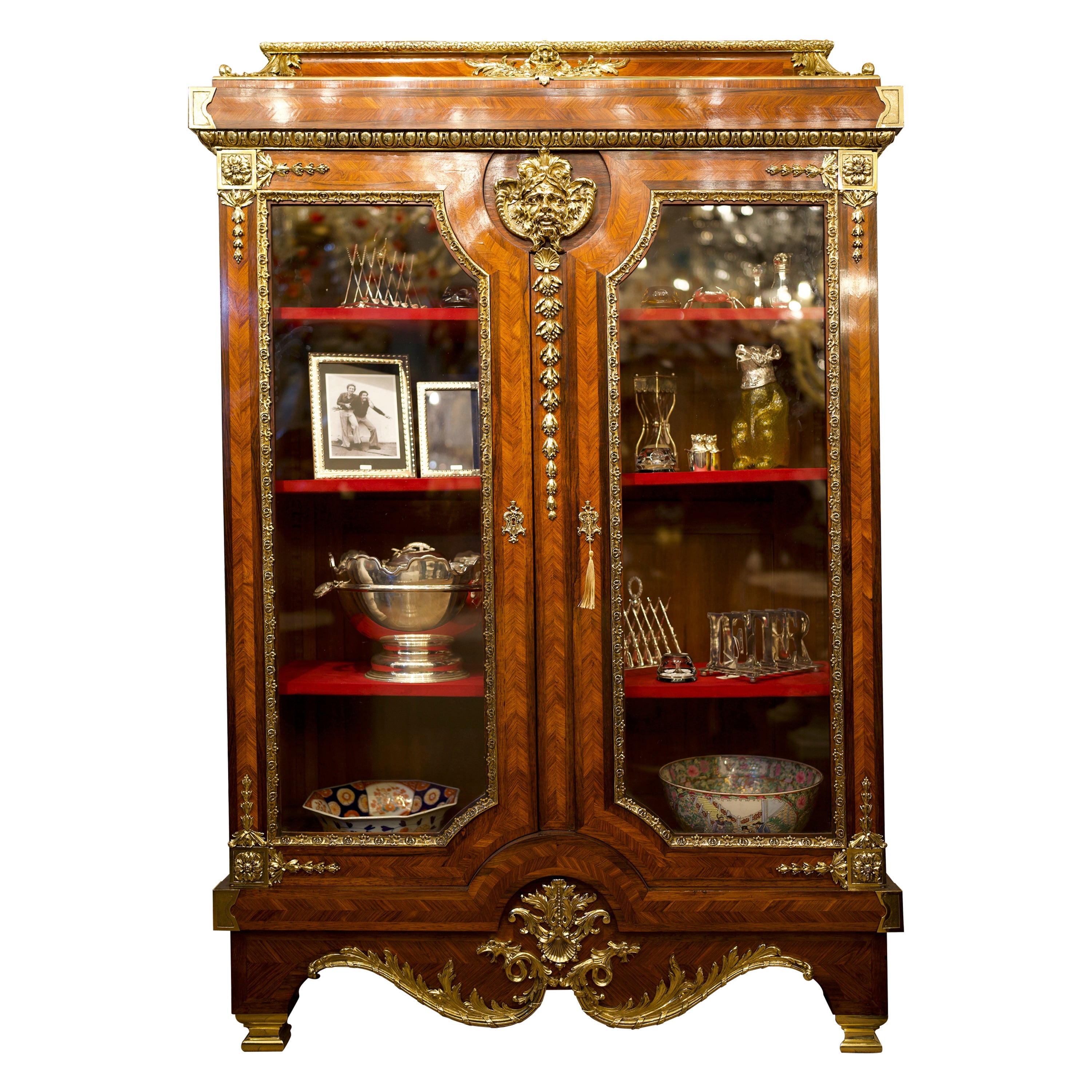Items Similar to Antique French Parquetry Ormolu Mounted Vitrine Cabinet 19th C
Want more images or videos?
Request additional images or videos from the seller
1 of 20
Antique French Parquetry Ormolu Mounted Vitrine Cabinet 19th C
About the Item
This is a beautiful antique French Louis Revival parquetry and ormolu mounted breakront vitrine, circa 1860 in date.
This beautiful cabinet has exquisite parquetry and crossbanded decoration with gilded bronze ormolu mounts. The shaped breccia marble top and cornice above a glazed panelled door enclosing glass shelves, and raised on elegant shaped ormolu mounted feet.
Complete with working lock and key.
It will add a touch of unparalleled style to your home and is perfect for displaying your collection of silver or porcelain.
Condition:
In excellent condition having been beautifully cleaned and waxed in our workshops, please see photos for confirmation.
Dimensions in cm:
Height 158 x width 129 x depth 49
Dimensions in inches:
Height 5 foot, 2 inches x width 4 foot, 3 inches x depth 1 foot, 7 inches
Parquetry - is a geometric mosaic of wood pieces used for decorative effect. The two main uses of parquetry are as veneer patterns on furniture and block patterns for flooring. Parquetry patterns are entirely geometrical and angular—squares, triangles, lozenges.
The word derives from the Old French parchet , literally meaning "a small enclosed space". Large diagonal squares known as parquet de Versailles were introduced in 1684 as parquet de menuiserie to replace the marble flooring that required constant washing, which tended to rot the joists beneath the floors.
Such parquets en lozange were noted by the Swedish architect Daniel Cronström at Versailles and at the Grand Trianon in 1693. Timber contrasting in color and grain, such as oak, walnut, cherry, lime, pine, maple etc. are sometimes employed; and in the more expensive kinds sometimes other tropical hardwoods are also used.
Ormolu - Gilt Bronze (from French 'or moulu', signifying ground or pounded gold) is an 18th-century English term for applying finely ground, high-carat gold in a mercury amalgam to an object of bronze.The mercury is driven off in a kiln leaving behind a gold-coloured veneer known as 'gilt bronze'.
The manufacture of true ormolu employs a process known as mercury-gilding or fire-gilding, in which a solution of nitrate of mercury is applied to a piece of copper, brass, or bronze, followed by the application of an amalgam of gold and mercury. The item was then exposed to extreme heat until the mercury burned off and the gold remained, adhered to the metal object.
After around 1830 because legislation had outlawed the use of mercury other techniques were used instead. Electroplating is the most common modern technique. Ormolu techniques are essentially the same as those used on silver, to produce silver-gilt.
Breccia Marble
Is a rock composed of broken fragments of minerals or rock cemented together by a fine-grained matrix that can be similar to or different from the composition of the fragments.
Breccia rock can be any colour and is very colourful. The colour is determined by the colour of the matrix or cement along with the colour of the angular rock fragments.
The word has its origins in the Italian language, in which it means either "loose gravel" or "stone made by cemented gravel".
For thousands of years, the striking visual appearance of Breccias has made them a popular sculptural and architectural material. Breccia was used for column bases in the Minoan palace of Knossos on Crete in about 1800 BC. Breccia was used on a limited scale by the ancient Egyptians, one of the best-known examples is the statue of the goddess Tawaret in the British Museum.
It was regarded by the Romans as an especially precious stone and was often used in high-profile public buildings. Many types of marble are brecciated, such as Breccia Oniciata or Breche Nouvelle.
Breccia is most often used as an ornamental or facing material in walls and columns. A particularly striking example can be seen in the Pantheon in Rome, which features two gigantic columns of pavonazzetto, a breccia coming from Phrygia, in modern Turkey. Pavonazzetto obtains its name from its extremely colourful appearance, which is reminiscent of a peacock's feathers,pavone is "peacock" in Italian.
- Dimensions:Height: 62.21 in (158 cm)Width: 50.79 in (129 cm)Depth: 19.3 in (49 cm)
- Materials and Techniques:
- Place of Origin:
- Period:
- Date of Manufacture:circa 1860
- Condition:
- Seller Location:London, GB
- Reference Number:
About the Seller
5.0
Platinum Seller
These expertly vetted sellers are 1stDibs' most experienced sellers and are rated highest by our customers.
Established in 1983
1stDibs seller since 2012
1,203 sales on 1stDibs
Typical response time: <1 hour
Associations
LAPADA - The Association of Arts & Antiques Dealers
- ShippingRetrieving quote...Ships From: London, United Kingdom
- Return PolicyA return for this item may be initiated within 14 days of delivery.
More From This SellerView All
- Antique French Ormolu Mounted Vitrine Display Cabinet, 19th CLocated in London, GBThis is a beautiful antique French ormolu mounted mahogany vitrine, circa 1870 in date. This beautiful cabinet is of slender form with gilt bronze ormolu mounts and a moulded cor...Category
Antique 1870s French Cabinets
MaterialsOrmolu
- Antique Square Ormolu Mounted Vitrine Display Cabinet 19th CenturyLocated in London, GBThis is an exquisite antique French bois violette vitrine of square shaped form with glazed sides and fabulous ormolu mounts, circa 1880 in date. This cabinet is elegantly crafted ...Category
Antique 1880s Cabinets
MaterialsOrmolu
- Antique French Vernis Martin Vitrine Display Cabinet 19th CBy Vernis MartinLocated in London, GBThis is a stunning antique French wood and Vernis Martin vitrine cabinet, in the Louis XV manner, Circa 1880 in date, with exquisite hand painted decoration and exquisite ormolu moun...Category
Antique 1880s French Louis XV Cabinets
MaterialsOrmolu
- Antique French Vernis Martin Vitrine Display Cabinet 19th CLocated in London, GBThis is a stunning antique French louis XV Revival Vernis Martin display cabinet, circa 1880 in date. The cabinet feature a shaped top with impressive ornate ormolu mounts, the body is serpentine shaped with a glazed ormolu mounted door that features a fantastic Vernis Martin hand painted panel of a courting couple, with the two side panels depicting country scenes. The interior is lined with the rich original pink fabric which beautifully complements the cabinet. Complete with original working lock and key. It is very rare to find such an exquisite cabinet and it is sure to attract a lot of attention from your guests. Condition: In really excellent condition having been beautifully cleaned, polished and waxed in our workshops, please see photos for confirmation. Dimensions in cm: Height 170 x Width 85 x Depth 43 Dimensions in inches: Height 5 foot, 7 inches x Width 2 foot, 9 inches x Depth 1 foot, 5 inches Vernis Martin is a lustrous lacquer substitute widely used in the 18th century to decorate furniture and such personal articles as brisé fans...Category
Antique 1880s French Cabinets
MaterialsOrmolu
- Antique Ormolu & Porcelain Mounted Table Top Credenza Cabinet 19th CLocated in London, GBThis is a stunning antique French Louis XVI Revival ormolu and Sevres porcelain mounted goncalo alves crossbanded satinwood and marquetry 'table-top credenza', Circa 1870 in date. ...Category
Antique 1870s French Louis XVI Cabinets
MaterialsOrmolu
- 19th Century French Louis Revival Parquetry Display CabinetLocated in London, GBThis is a stunning antique French mahogany and ormolu-mounted display cabinet in the French Louis XV manner, circa 1870 in date. This beautiful cabinet has an abundance of exquisite...Category
Antique 1870s French Louis XV Cabinets
MaterialsMarble, Ormolu
You May Also Like
- French Kingwood Parquetry and Floral Ormolu-Mounted Cabinet, 19th CenturyLocated in London, GBFrench kingwood parquetry and ormolu-mounted vitrine. In the Louis XV-XVI Transitional style, of kingwood and tulipwood crossbanding and o...Category
Antique 19th Century French Louis XV Cabinets
MaterialsOrmolu
- 19th Century Ormolu-Mounted Parquetry Cabinet by François LinkeBy François LinkeLocated in London, GBAn Ormolu-mounted and mahogany parquetry cabinet by François Linke Constructed in the Louis XV transitional manner, in mahogany parquetry work, and dressed with ormolu mounts of ...Category
Antique Late 19th Century French Louis XV Cabinets
MaterialsMarble, Ormolu, Bronze
- 19th Century French Ormolu-Mounted 'Vernis Martin' VitrineLocated in Los Angeles, CAA stunning and unusual French 19th century Louis XV Style gilt bronze-mounted and "Vernis Martin" style bombé tulipwood veneered vitrine cabinet. The serpentine front door vitrine wi...Category
Antique 19th Century French Vitrines
MaterialsTulipwood
- 18th Century Ormolu Mounted French Kingwood Cabinet/VitrineLocated in Southall, GBA stunning 18th Century Ormolu Mounted French Kingwood Cabinet/Vitrine. The cabinet features twin large glazed doors. Each door is finished wi...Category
Antique 18th Century French Cabinets
MaterialsKingwood
- French Stone Overlay Ormolu Mounted Cabinet, 19th CenturyLocated in Miami, FLImpressive 20th century French Napoleon III stone overlay ormolu mounted ebonized cabinet with grey vetted marble top. The shaped grey marble top is over a frieze with gilt bronze...Category
Early 20th Century French Renaissance Revival Linen Presses
MaterialsMarble, Bronze
- French Stone Overlay Ormolu Mounted Cabinet, 19th CenturyLocated in Cypress, CAImpressive 19th century French Napoleon III stone overlay ormolu mounted ebonized cabinet with black marble top. The shaped black marble top is over a gilt bronze mounted frieze in an leaf-tip motif with an egg and dart border, above a large single door...Category
Antique 19th Century French Napoleon III Cabinets
MaterialsStone, Marble, Bronze
Recently Viewed
View AllMore Ways To Browse
Type Case
Best Case
Ormolu Mounted French
Museum Case
Case Gold French
Used Museum Cases
Vitrine Cabinets
Antique Key Storage
Antique Key Cabinet
Small French Cabinet
French Modern Cabinets
French Modern Cabinet
Antique Old Cabinet
Old Antique Cabinet
Scale Case
Antique Cabinet With Key
Antique Cabinet Large
Small French Storage Cabinet





